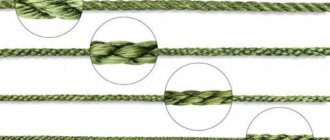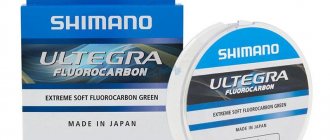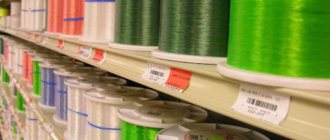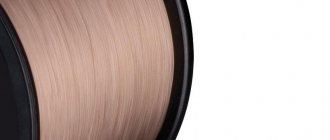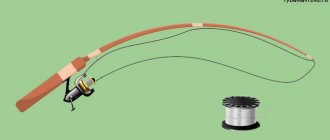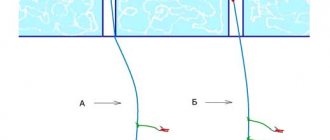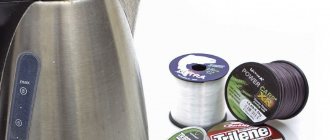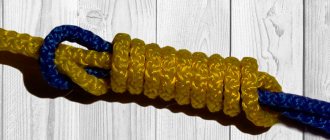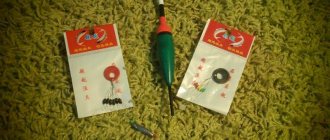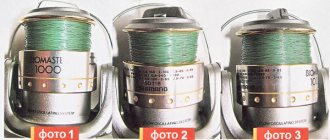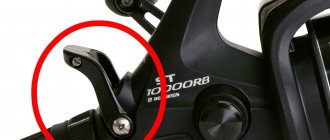Properties of fluorocarbon
Unlike fishing line, fluorocarbon does not refract light as much. This means that there is a possibility that the fish in the water simply will not notice it.
At least until deposits and water deposits appear on it.
Resistance to external conditions and mechanical wear. Fluorocarbon is not affected by ultraviolet radiation, and resists mechanical stress, such as abrasion from the ground and shells, and fish snacks.
Fluorocarbon line sizes are measured in pounds, or Lb.
Myth 2 Fluorocarbon is not visible underwater.
Manufacturers claim that fluorocarbon is invisible under water, especially compared to monofilament, unfortunately this statement is quite difficult to prove or disprove, we do not know how fish see.
We recommend: Does it make sense to use UV and fluorescent baits to catch a predator?
From various tests of these lines, there is little or no difference in visibility between nylon lines and fluorocarbon lines.
Refractive index:
- Water – 1,333.
- Fluorcarbon – 1.42.
- Nylon monofilament - range from 1.53 to 1.62.
As you can see, the difference in numbers is not big. Again, we should not forget that any fishing line, when lowered into the water, will create various vibrations and vibrations, which the fish perfectly feels with its lateral line, and the larger the diameter of the fishing line, the stronger these vibrations will be, so any fishing line under water will be noticeable to the fish.
This explains that the worse the bite in a pond, it is most effective to use a fishing line with small diameters, up to 0.08 mm, this reduces the vibrations of the fishing line in the water, and the fish are less afraid.
Here are the results of our test:
Test layout
The photo clearly shows both types of fishing line; in the summer we will definitely conduct a test in a natural body of water, underwater, lowering the camera under water.
Fluorocarbon Strength
Many people blame fluorocarbon for being less durable than fishing line. This is partly true, but this is due to incorrect operation. The carbon fiber from which fluorocarbon is made is stiffer than fishing line fibers. This means that it does not stretch and it cannot absorb sudden jerks, so it breaks more often and it deteriorates.
You can combat this situation by choosing a larger fluorocarbon diameter, or by correctly adjusting the drag on the reel, or by using special shock absorbers on the rod.
Unlike fishing line, fluorocarbon is not as sensitive to abrasion, so it is good to use as a leader when catching a predator, such as pike.
Please note that with each pike bite, microcracks will appear on the fluorocarbon leader, which will ultimately lead to breakage. Accordingly, change it on the spinning rod more often.
Fluorocarbon line material and color
A material called fluorocarbon was discovered and patented in 1969 in Japan by Kureha. Similar in structure to Teflon, it was previously used, in addition to the production of fishing line, in the chemical and petrochemical industries. In the seventies, the first versions of fluorocarbon lines appeared in the markets of North America (Seaguar) and Western Europe (Riverge)
As for color, we must take into account that different fish have significant morphological and anatomical differences among themselves, including in the structure of the visual analyzer (in other words, in the structure of their eyes). They "generally" see colors, but compared to humans, their eyes are more sensitive to warm colors, that is, yellow, orange and red. If you need to attract fish with bait, these colors are, of course, welcome. But a fishing line of this color will simply scare many fish.
The color of the environment is also important. Red line will blend with a reddish tint, for example, in ponds where timber rafting is carried out, or on peat lakes. This applies mainly to freshwater fish, since for marine fish the color of the fishing line is much less important. In freshwater bodies of water, red, yellow and orange fishing lines are clearly visible to fish even in muddy water, since red and yellow colors correspond to light with a longer wavelength, and it is less scattered by turbidity (suspension) particles. However, the fish’s perception of red-colored fishing lines extends to approximately a depth of 5 m.
Green, blue, bluish fishing lines are less noticeable, since, depending on the illumination of the reservoir, they often merge with the water and the sky reflected in it. Fish, as a rule, are less wary of these colors and will pay less attention to such fishing line. But this applies to pelagic and coastal fish. If you are fishing at great depths with poor lighting, then any fishing line will be less noticeable, and this must be taken into account.
According to ichthyologists, white fishing line will be clearly visible to fish both at depth and at the surface; this color frightens fish, and they can identify it perfectly. The only exceptions are very cloudy days.
The next factor that you need to pay attention to when choosing the color of the fishing line is the season. In winter, in reservoirs that are covered with ice, the vision of fish is more sensitive to multi-colored and bright fishing lines. And in the open water season, in conditions of poor visibility (cloudy weather, muddy water, etc.), fish are well attracted by any light and bright bait, but such a fishing line is scary. Thus, in the winter season, taking into account the peculiarities of the color vision of fish, a transparent colorless or slightly bluish monofilament line or a fluorocarbon line would be preferable.
For fish that live at great depths, braided fishing line (excluding bright fluorescent line) will not be noticeable. In summer, conditions are more varied, and it is difficult to give clear recommendations on the choice of fishing line color. The fishing line is selected based on the color of the water in the reservoir, the presence of vegetation, the color of the bottom and other factors. In muddy water, line color is usually not critical to camouflage, but there are exceptions. In any case, you need to choose the color of the fishing line, first of all, based on the object of fishing.
Dark fishing lines in muddy or cloudy water are hardly noticeable for ide, silver bream, white bream, perch and some other fish. And for fishing for carp and carp, a dark, even black color of fishing line is preferable.
Visual acuity in predatory fish is an order of magnitude lower, and the color of the fishing line does not matter so much.
Why a fluorocarbon leash is better than others
It is flexible, soft and difficult to see by fish; these are its main properties.
Additionally, they are easy to make yourself, and one spool of fluorocarbon line will last for many years.
Otherwise, metal leashes are more resistant to bites of predatory fish, they have a smaller diameter and higher strength. But often the fish ignores them, especially when fishing during periods with a bad bite.
A fishing line from 0.4 - 0.6 mm is used as a leash for pike; even despite such a large diameter, they are still less noticeable to a predator.
It’s impossible to say better in this case, each leash has its own purpose and everything is selected empirically and through practical tests on each body of water.
We recommend: How to deliciously cook fish over a fire
Fluorocarbon leashes are irreplaceable when catching large, cautious fish; they are different for pike; often large pike easily bite through them.
Fluorocarbon for a leash, how to use it
Most often, fluorocarbon is used to make leashes or parts of equipment in spinning rods and feeders. It is used where its hardness, wear resistance and rigidity are needed.
Fluorocarbon (technically correct - fluorocarbon, Fluorcarbon) turns out to be resistant to abrasion, it retains the desired twist shape, and it also resists pike teeth well, and compared to steel, it is much lighter and more elastic.
General information
Fluorocarbon is a polymer derivative of Teflon, created in Japan quite a long time ago and used in fishing gear since the end of the last century. It is distinguished by its hardness, wear resistance and the fact that it does not age and does not lose its properties over time. Invisibility in water (refractive index 1.42, near water 1.33) makes it even more popular among fishermen.
It is also 1.5 times heavier than regular nylon fishing line and 80% heavier than water and sinks 2.5 times faster. But at the same time, fluorocarbon fishing line has noticeably less strength compared to conventional monofilament. Those. To maintain strength, you need to install thicker material.
How thick is a fluorocarbon leash for spinning rods?
When making a thick fluorocarbon leash for spinning, the fight is primarily not with breaking force, but with pike teeth. Based on experience, it is believed that a leash with a diameter of 0.4 mm (thinner is not recommended for pike) will remain intact in 70% of bites. To ensure that the probability of preserving the tackle and trophy exceeds 90%, a diameter of 0.6 mm is used.
But if you take it even thicker, then another problem arises: you cannot knit knots, you can only connect them with crimp tubes, which also require a special tool. Therefore, they often stop at values of 0.5 - 0.6 mm when it comes to a leash for a pike.
Making a regular pike leash
When making any equipment from fluorocarbon, you need to take into account that a significant length will be spent on knots and the formation of loops, because the material is large in diameter and rigid. Loops on fluorocarbon can be tied with a regular simple knot, but the tightening must be forceful, and the loop must be placed on something strong without sharp edges - a steel pin...
Only after wetting (required) and forcefully tightening will the knot on a 0.4 - 0.6 mm thread not come undone. As an option - a loop made of fluorocarbon as in the photo, to be on the safe side you can add a drop of instant glue, it will not spoil the material.
To tie a regular fluorocarbon leash for a spinning rod you need:
- Cut 40 cm of monofilament with wire cutters.
- Tie a simple loop to connect to the cord (or, if desired, insert a swivel, possibly with a self-tightening knot, more on that later...).
- Tie a simple loop on the other side around the winding ring, loosely, without tightening it (fastening baits with clasps is still not 100% reliable...).
Options for using fluorocarbon as leashes and shock leaders
- Sinking leaders in fly fishing and in the feeder. It must be taken into account that the current lifts light baits, which is not always pleasant for experienced anglers looking for large bottom fish. In addition, stiffer leashes cause less tangling. How the fish will react to an increase in hardness, but with invisibility - everything is tested experimentally, but the option is working...
- Leash for jig-spinning, when fishing with braid, especially in snags, in thickets. The braid is too noticeable in the water, as it is filled with air bubbles and looks massive, but most importantly, it quickly frays when in contact with obstacles, with the bottom. A fluorocarbon leash of pike diameter is attached with a loop; it is not allowed into the tulip of a spinning rod, so a compromise is sought between length and ease of casting. Long leashes (up to 3 meters) made of thin fluorocarbon 0.2 - 0.3 mm are tied with compact knots and can pass into the tulip.
- Shock leader on the donk against the shell rock. Often the edge ridge is covered with shells, while the feeder is used to fish at the lower edge of the edge, or a little further, in a hollow filled with drifted food and fish. In such conditions, cord and monofilament quickly wear out and break. A shock leader made of fluorocarbon can help out in such a fishing spot, but the rings must be large and the tie knot must be neat.
- Invisible leash for catfish. Catfish tackles have recently begun to be equipped with thick fluorocarbon leashes. What is more important here is the invisibility and heaviness of the material, placing bait on the bottom or jigging the bait.
Experienced fishermen recommend preparing spare leashes for pike and changing them on time if necessary. Detecting violations is easy - just run your fingers along the monofilament.
What knots to tie fluorocarbon leashes to?
If the knot between the braid (monofilament) must pass through the rings, then it is made as compact as possible.
- The Albright knot for fluorocarbon has minimal dimensions. More often, thin braid is connected in this way with fluorocarbon with diameters of 0.2 - 0.3 mm. A thick fishing line is bent and tied in 10 turns - pay attention to the direction of winding - from the tip of the bend towards the loop.
After wetting and tightening with great force, the tips are cut close to the knot - nothing is left, the knot works when passing through the tulip both in feeder fishing and when using a jig in a spinning rod.
- The Carrot knot is similar to the previous one and forms a compact connection. Typically, such a knot is recommended by experienced feeders for attaching part of a fluorocarbon fishing line.
It should be noted that long leashes and shock leaders are tied at the end of braids directly while fishing, when circumstances force them to be used. Short leashes from pike teeth or twists for the feeder are prepared at home and delivered in leashes for fishing.
Now a couple of complex self-tightening knots for fluorocarbon. You can tie the leash to the clasp or swivel using a compact knot according to the following diagrams.
The Rapala knot is used. And then comes Grinner.
Spinning anglers should take into account that pike perch and pike perch are very skeptical about metal leashes. They evaluate fluorocabron more positively, and pike respond better to it. The material is softer and inconspicuous, so it makes sense to make and use fluorocarbon leashes...
How to knit fluorocarbon
Knots are always the weak point of all fishing tackle; many knots weaken the line by more than 50%. Due to the rigidity of fluorocarbon lines, tying it is not a big problem.
Several knots are suitable for tying fluorocarbon: Albright Knot, Carrot Knot, Alberto Knot.
- Albright Knot weakens after a while, so it needs to be checked periodically.
- Mahin Knot has a theoretical strength of 98% and is durable, but it can also have problems.
- Alberto Knot the problems are the same.
Tip: Use super glue or other waterproof liquid adhesives to protect the assembly from loosening. A small drop is enough and your knot will never come undone.
Video
Albright knot for fluorocarbon:
Mahin Knot
Alberto Knot
Useful tips for choosing
Once in a fishing store, many beginners are simply lost and don’t know which option to buy. In order not to make a mistake with your choice, you need to take into account a lot of features and weigh the pros and cons .
The first step is to decide on the type of fish and the place where the fishing will take place. You also need to take into account the stretchability, diameter and transparency of the tackle, since these factors directly affect the success of the upcoming fishing.
There is an opinion among fishermen that the smaller the diameter of the fluorocarbon line, the more invisible it is in the water column. However, this is not always the case, because even thick models are almost transparent. Most often they are used for highly sensitive fishing rods or spinning rods used when catching cautious inhabitants of the depths.
Thick fluorocarbon is better suited for reliable spinning fishing rods , when a lot of force must be exerted when winding the fishing line. If fishing is carried out on a large lake, where there is a chance of catching a large trophy, then transparency can be relegated to the background - here durability is an important selection criterion.
Depending on the specific fishing conditions, the angler needs to choose the right fishing line. By the way, Japanese researchers have confirmed the fact that the use of fluorocarban fishing line as a leader material directly affects the frequency of bites. They proved that with this invisible thread in the equipment, the number of fish caught doubles.
Which fluorocarbon to choose
Fluorocarbon fishing lines are quite expensive. But since it is usually used to make leashes, and one reel will last for a long time, you should not skimp on it.
Buy products from well-known brands such as Mikado, Dragon, Berkley or higher price segments. It makes no sense to look for products from little-known brands, since the manufacturing technology of such fishing lines is complex and little-known brands will most likely have low-quality fluorocarbon. Write your reviews of fluorocarbon in the comments.
Share link:
The best fluorocarbon fishing line.
Seaguar Invizx 100% fluorocarbon.
One of the main reasons you might want this line is because it is almost invisible in the water.
This gives the fish less chance of seeing your line and escaping.
It rolls very smoothly on a spinning reel or bait without a ton of play.
If your knots are tied properly, this line will have exceptionally strong tension when struck by aggressive or large fish.
The only downside to this line is that it can be somewhat sensitive to abrasion on rocks or in water.
Therefore, it may be more suitable for outdoor use.
To reduce the chance of the line being cut, you can use a long metal leader.
Or create your own leader with wear-resistant fishing line.
Overall, the Seaguar Invizx will perform very well when targeting those elusive trophy fish that always spook when they see a line.
KastKing FluoroKote line.
The KastKing FluoroKote is a treasured choice for fishermen looking for fishing line.
It has the strength of monofilament line and the low visibility or diameter of fluorocarbon.
Crankbaits and bait throwers will love this line because it sinks very quickly in the water, allowing the bait to dive deeper with less line retrieval.
It also has exceptional abrasion resistance.
So you don't have to worry about that line breaking on sticks or rocks when a fish takes your bait for a trip.
However, you won't have much luck with this line in a lure or light bait as it can easily backfire once applied.
Knots can also slip if you don't secure them properly.
So make sure you tie an extra knot or two.
Overall, this is a great line for fishermen who throw those expensive lures into cover and like to dive fast.
Seaguar Abrazx 100% fluorocarbon.
Like the Seaguar Invizx, you can use this line as a bait or spinning reel without experiencing backlash and still have smooth casts.
It uses the same internal monofilament material as Invizx.
This makes it a very strong line for fighting heavy fish.
Unlike the Invizx, this line is geared more towards heavy cover use rather than poor visibility in the water.
And this can be great if you want to use it as leadership material as well.
Line visibility is still quite low.
It can be used in most situations unless you are fighting a super-slick fish.
To help manage line visibility, you can fish in murky water.
Because it is very abrasion resistant, it tends to be very slippery.
Therefore, extra care may be required to avoid losing fish or bait.
Overall, the line is extremely resistant to scratches and cuts in water.
P-Line Floroclear Clear Line.
The best fluorocarbon fishing line.
If tying fishing knots all the time isn't your strong suit, but you still want to use fluorocarbon line, you'll love the exceptional strength of P-Line Floroclear knots.
The knots slipped every time, but it sticks and holds, even when the fish twitches.
It drops very smoothly and has very low linear memory.
This means less time spent fighting backlash and more time spent fighting fish.
Although you can use it in somewhat clear water, it is not completely clear.
Some fish may decide not to bother with your bait, especially if they are finicky fish.
Because it has low abrasion and impact resistance, it may be more suitable for open water fishing for species that do not pull aggressively.
Sufix Invisiline Casting Fluorocarbon.
When you are used to monofilament but want to use fluorocarbon, you can start with Sufix Invisiline.
It has the low visibility of fluorocarbon with the same great strength and stretch of monofilament.
You can even use it in bait if you want.
In addition, it is very sensitive to bite, which helps when catching timid fish.
It works similarly to monofilament.
You can count on some line memory for the first few casts.
This line can be a great all-around choice for any fisherman.
Try fluorocarbon, no matter what type of reel you use.
Seaguar Blue Label Fluorocarbon Leader.
The best fluorocarbon fishing line.
In my opinion, this is the best leader in the fishing industry.
This is the best fluorocarbon leader in my top three lines across the spectrum.
I always have this line when I'm fishing.
It was the most reliable fishing line with superior strength and ease of use.
100% fluorocarbon and invisible underwater.
This leader line is a step above standard fluorocarbon mainlines.
However, you will have to pay a little more money.
You are investing in top quality leader line!
This is the line you attach to your hook and is closest to the fish.
It's worth spending money on this leader.
